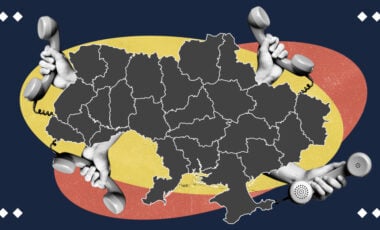Chornobyl: what's happening at nuclear power plant after 36 days of occupation ended
Thirty-six years ago, on April 26, the Chornobyl catastrophe happened. This year, Chornobyl underwent a new test, the russian occupation, when from February 24 to April 2, the ruscists captured Chornobyl. Rubryka tells the story of the world's most famous nuclear facility occupation: stolen cup sets, destroyed archives, radioactive "souvenirs," and inhumane working conditions for scientists.

What is the problem?
Every Ukrainian knows what Chornobyl is. The entire planet felt the effects of the 1986 radiation emission. Today, on April 26, Ukraine celebrates another anniversary of the Chornobyl catastrophe. On this day, 36 years ago, the fatal Chornobyl disaster happened, still echoing in many Ukrainian families.
With the beginning of russian aggression, Ukraine and the world were in danger of a new catastrophe. On February 24, russian armored vehicles passed through this territory, raising radioactive dust into the air. The russian invaders seized the Chornobyl station with force and weapons. russia has turned this facility into an arena of war. The occupiers used the 30-kilometer exclusion zone to prepare new attacks against our defense, and the Chornobyl nuclear power plant itself was threatened with damage and destruction.
Fortunately, the global catastrophe didn't happen. Still, it will take years after russian troops leave the Chornobyl nuclear power plant to investigate which radioactive waste burials they damaged, how radioactive dust spread, and what damage russian barbarians did to Ukrainian soil.
They came with threats to "turn everyone into meat"
russian troops captured the Chornobyl nuclear power plant on the first day of a full-scale war, on February 24. About 300 people, personnel and military, who were at the station, became occupiers' hostages.
As one of the station employees later said, a column of tanks arrived at the Chornobyl nuclear power plant from the side of Prypiat, approached one of the buildings on the territory of the Chornobyl nuclear power plant, and aimed their guns at the building. The russians threatened to "turn everyone into the meat." And the threat was made even though it is strictly prohibited to conduct hostilities on the nuclear facility territory. The commander of the Ukrainian National Guard ordered our soldiers to lay down his arms.
"At about 3 o'clock, we saw 'men in black' coming into the plant. They climbed from all the holes. They broke our equipment. Our military had already taken up positions; they were ready to go into battle. Then there were talks between them," another plant employee said. "Then they told everyone to keep working. Since then, we haven't left the workplaces and worked, worked, worked."
Saving the world from catastrophe
While the ruscists trapped Chornobyl personnel and the National Guard, Rosatom planned to seize control of the Chornobyl nuclear power plant by sending "specialists" and preventing staff rotation. Every day the number of occupiers increased. russians forced plant employees to work around the clocks: no breaks, no moving freely around the territory. Access to health care was also restricted.
Another dangerous object in the Chornobyl zone was the storage facility for spent nuclear fuel. On March 9, the russians damaged the power supply to the Chornobyl nuclear power plant and the spent nuclear fuel storage facility. The Energoatom energy company warned that prolonged de-energization of the storage facility, which stores 20,000 spent fuel assemblies, could lead to overheating and evaporation of radioactive substances that could contaminate Ukraine and European countries like Belarus and russia. The occupiers refused to grant access to the station to Ukrainian maintenance specialists. Instead, they tried to send "Belarusian specialists" on Lukashenko's instructions. Only four days later, thanks to the heroic work of Ukrainian repairers, Ukraine was able to restore power to the station and storage.
And even in such conditions, Ukrainian experts were able to maintain control over the nuclear facility, effectively saving the world from disaster.
"I wasn't afraid for my life. I was afraid that a tragedy for humanity could happen." In hostage
For more than a month, the occupiers kept the Chornobyl personnel, the National Guard, and four "stalkers," who happened to be in the exclusion zone at the beginning of the russian invasion, at the barrel of a gun.
The employees who met the russian invasion were on shift for 600 hours instead of the standard 12. The occupiers were not anxious that a person should be focused during the Chornobyl monitoring work; fatigue weakens self-control. During the occupation, station workers took turns sleeping. They organized the shifts themselves because there weren't enough people: a couple of hours of work and hours of rest. One person was left on duty for the night. They slept in chairs, on the floor, and tables.
Employees of the station ate at the station's reserves. The dining room has warehouses, refrigerators, and a freezer. Portions had to be reduced so that there was enough food for everyone. The staff tried their best, but on the 6th day, the cook fainted; she had no strength to work. Four stalkers set out to help the canteen workers, who crossed the Chornobyl Exclusion Zone before the full-scale invasion began without any permission. They came to the nuclear power plant when they realized that fighting was already going on around them, and they were also taken, hostage.
They didn't take food from the occupiers, although the russians brought "humanitarian aid" constantly to create an "image for the media." When the Chornobyl personnel refused ruscist c-rations, the invaders disguised their military in the form of the NOVARKA concern, which hadn't been operating in the exclusion zone for more than a year, and they shot the propaganda video.
"When there were problems with electricity, and we needed to supply the station with generators, we stole fuel from the occupiers to prevent a catastrophe," said Chornobyl engineer Valerii Semenov. "If we'd lost electricity, it could've been a disaster. "You can imagine the scale of this. I was not afraid for my life. I was afraid of what would happen if I didn't maintain the station. I was afraid that there would be a tragedy for humanity."
Workers managed to scare the occupiers that without fuel, everything would explode. The occupiers wanted to live. Therefore, they began to drain fuel for generators from their equipment. So, instead of 48 hours, they managed without electricity for four days.
Radio was the only means of communication, so Ukrainians constantly listened to what was happening in Ukraine. There was no mobile service or internet. The nuclear power plant employees spent more than 24 days in tension and constant work before Ukraine managed to organize the rotation.
"Where is the US military? Where are the NATO bases?"
At first, some station workers tried to communicate with the occupiers; they wanted to understand how people in their right minds could start this war. But it turned out that they were just zombies. The russians believed that they were bringing peace and liberation to Ukraine.
Stalkers who crossed paths with the occupiers while working in the kitchen confirmed the impression of the Chornobyl engineers. "Before we talked, we didn't think they were so stupid. What you see on TV are their handbooks. And here you see it in real life. And you are asked all the template questions: where is the US military? Where are the NATO bases?" one of the stalkers talked about speaking to the occupiers.
The soldiers had no idea of the danger of the place and didn't understand why they needed dosimeters. They enlisted in the army to "pay for a mortgage" or avoid being imprisoned again.
At first, stalkers say the mood among the russian military was uplifting, but later it changed. All the news, except that reported by their officers, was about the incredible number of russian casualties in Ukraine. Of course, Rosatom employees, who later arrived at the Chornobyl nuclear power plant, were aware of the station's history. "They knew that we stored spent nuclear fuel here, but they were also zombies," said a Chornobyl employee.
Trenches in the Red Forest and porridge made of coffee beans
The ignorance of the russian soldiers went beyond scale, as did the dosimeters, which were then used to check the radiation background at the invaders' deployments. They dug bare soil contaminated with radiation, collected radioactive sand in bags for fortifications, and breathed this dust. According to experts, after a month of such exposure, they have one year of life. It will be not even life but a slow death from disease.
Thousand russian soldiers were on the Chornobyl nuclear power plant's territory before russian troops withdrew, and up to 500 soldiers were in the city of Chornobyl. How many of them sat in the woods in the trenches that Ukraine is now discovering is still unknown. Not only the entire personnel of the occupiers and "trophies" became infected, but also all the military equipment that passed through Chornobyl; it is about 10 thousand units. Every russian soldier will bring a piece of Chornobyl home. Alive or dead.
It's not an exaggeration. In early April, the first death of a russian soldier from radiation sickness was recorded. Many media outlets wrote about this case, referring to russia's military medical service. In general, several dozen people were hospitalized after the russians left the Chornobyl zone and were sent for forced examination and treatment because of critical conditions. The "training" of the occupiers in the Red Forest was quite "successful."
The stupidity of russians wasn't limited to ignorance of the dangers of radiation. The ruscists cooked porridge… out of coffee beans in the Red Forest. What they wanted to get as a result is a mystery to a civilized person, but the technology of coffee has been known to humanity from XV-XVI centuries. From a glance at a pot of burnt coffee beans, we can conclude that the orcs that dug up near the Chornobyl nuclear power plant lagged behind the rest of humanity by about 500-600 years.
Radioactive souvenirs, forks, spoons and sets
On the evening of March 31, it became known that nuclear terrorists from russia were leaving the territory of the Chornobyl nuclear power plant. Leaving the Chornobyl nuclear power plant, russian bandits also took with them everything they could.
Chornobyl had two laboratories to study current radiation exposure problems and the characteristics of substances. The occupiers destroyed the laboratory at the Ecocenter and entered the ionizing radiation storage facility, which stored exemplary radioactive solutions and calibration sources. There, orcs stole and damaged 133 sources of ionizing radiation with an activity of about 7 million Becquerels, which can be compared with 700 kg of radioactive waste with the presence of beta and gamma radiation.
Energoatom says that even a tiny part of this activity is deadly if one handles it unprofessionally. It is unknown where the stolen sources are now. The occupiers could likely have taken fuel samples and sources of ionizing radiation as souvenirs.
The occupiers also destroyed and looted the Institute for Nuclear Safety offices and laboratory. The russians took out computers and office equipment and smashed laboratory equipment and measuring devices. Documents and archives collected for decades were thrown away by the orcs.
Garages with cars transporting scientists were also looted. They even took out spare parts. Of the 15 sea containers that were on the territory of the small construction base, they also took six away.
During the occupation of the Chornobyl zone, the russians managed to seize a new MAZ fire truck. But they did not take it to russia and disassembled it into spare parts like a locust. They removed devices, steering wheel, fire equipment, hydrants, hoses, headlights, seats, steering wheel, and all wheels from the new fire truck.
The occupiers even stole headlights from a VAZ 21011 car in the Chornobyl historical reconstruction of Road Inspection post:
Before leaving the Chornobyl nuclear power plant, russian looters also robbed a nearby hotel. The occupiers stole computers, kettles, and coffee makers. They took out kitchen utensils, forks, spoons, and cup sets.
The station's director was shocked by the behavior of the russians. He was relieved to note that "the safety equipment and life support systems of the Chornobyl nuclear power plant haven't been looted and remain intact."
The fate of the National Guard
The military unit, which guarded the Chornobyl nuclear power plant and consisted mainly of soldiers of the National Guard of Ukraine, resisted the occupiers but was forced to lay down its arms due to the lack of heavy weapons and the danger occupiers attacking critical facilities. They were held captive by the russians throughout the Chornobyl occupation.
When the occupiers withdrew, the National Guard was taken away. They were taken out in prisoner transport—all 169 people. When Energoatom employees asked russians where the soldiers were and what was happening with them, the answer was: "It's none of your business. They will be in russia."
One of the National Guardsmen managed to contact his wife in early April.
A woman said that the prisoners could be in Smolensk, russia, and Bragin, Belarus. According to the couple, they are starving and not given water. In addition, nothing is known about their health; most likely, the National Guard needs medical attention. By doing so, russia is grossly violating the terms of the Geneva Convention on the Treatment of Prisoners of War.
According to Interior Minister Denys Monastyrskyi, Ukraine is currently negotiating the exchange of 169 National Guardsmen who were taken prisoner by the russians.
What is happening at the Chornobyl nuclear power plant now?
Since April 2, the Ukrainian flag has been hoisted over the Chornobyl nuclear power plant again. On April 20, the IAEA managed to re-establish direct contact with the Chornobyl station, which the russian military had occupied for more than a month. Now Energoatom employees continue to put things in order and calculate the losses from the occupation.
On the anniversary of the Chornobyl catastrophe, the employees await an official visit of IAEA experts led by Director General Rafael Grossi. The IAEA team on nuclear safety, security, and safeguards will be in Chornobyl from April 26. Experts will bring the necessary equipment and conduct radiological and other tests at the Chornobyl nuclear power plant.
The way the russians behaved at the Chornobyl station once again confirms their essence. Wickedness, looting, and cruelty are natural states for them, like breathing.
A nuclear disaster has threatened Ukraine, Europe, and the whole world. They kept Chornobyl workers under occupation for 36 days, trying to take control of the station. They also stole and robbed everything they saw around them. And when they fled, they took everything that had even the slightest value.
In contrast, we are incredibly proud of Ukrainians, the workers of the station, who defended the Chornobyl nuclear power plant and saved us from tragedy. They are real heroes. Thank you for saving Chornobyl!




























































